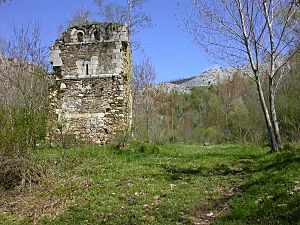Gonzalo Rodríguez Girón facts for kids
Gonzalo Rodríguez Girón (born around 1160, died 1231) was a very rich and powerful noble in the Kingdom of Castile. He was the first son of Rodrigo Gutiérrez Girón and María de Guzmán. Gonzalo lived in an area called Tierra de Campos. He was a very loyal supporter of King Alfonso VIII of Castile, Queen Berengaria of Castile, and later King Ferdinand III.
Contents
Serving the King and Queen
Gonzalo was part of King Alfonso VIII of Castile's royal court. He served as the High Steward (a very important royal official) from 1198 until the king died in 1214. Gonzalo and his brothers, Rodrigo, Pedro, Nuño, and Álvaro, all fought in the famous Battle of Navas de Tolosa on July 16, 1212. This battle was a major victory for the Christian kingdoms against the Almohad Caliphate.
After King Alfonso VIII died, Gonzalo continued as High Steward for the young King Henry I. However, in 1216, Count Álvaro Núñez de Lara became the young king's guardian. Álvaro Núñez de Lara did not get along with the church or many nobles. He replaced Gonzalo as High Steward. Because of this, Gonzalo and his supporters became loyal to King Henry's sister, Berengaria.
In February 1216, many Castilian nobles, including Gonzalo, met to form a group against Álvaro Núñez de Lara. They had the support of Berengaria. By May, the situation was dangerous for Berengaria. She went to her castle in Autillo de Campos, which belonged to Gonzalo. She also sent her son Fernando to his father, King Alfonso IX of León, in León. In August 1216, nobles tried to make peace, but it didn't work. Gonzalo's family and others decided to completely separate from Álvaro Núñez de Lara.
The year 1217 was very tense in Castile. Álvaro Núñez de Lara refused to give up his power. He attacked areas loyal to Berengaria, including Trigueros. He also surrounded Berengaria and her supporters in Autillo de Campos, and attacked Cisneros and Frechilla.
Things changed suddenly on June 6, 1217. King Henry I died after a roof tile accidentally hit his head while he was playing. Álvaro Núñez de Lara tried to keep the death a secret. He took the king's body to Tariego castle. But the news still reached Queen Berengaria.
Berengaria quickly asked Lope Díaz de Haro, Gonzalo Rodríguez Girón, and Alfonso Téllez de Meneses to bring her son Ferdinand. Ferdinand was in Toro with his father, King Alfonso. They used the excuse of a possible attack on Autillo, without telling anyone that King Henry had died. Even though some people were unsure, the nobles convinced King Alfonso that King Henry was fine. They left Toro with Ferdinand. Berengaria was the rightful heir to the throne of Castile. But she gave up her right to her son Ferdinand. He was then declared king in Autillo de Campos on June 14, 1217.
Later that year, Alfonso Téllez de Meneses captured Álvaro Núñez de Lara. Álvaro had to give up some of his castles. A truce was signed, allowing Álvaro to be free and get his privileges back. But as soon as he was released, Álvaro challenged his enemies again. He died while trying to attack them in the fortress of Castrejón de Trabancos. His brother went to Morocco. Finally, a peace agreement called the Pact of Toro was signed on August 26, 1218. This ended the conflict.
Important Positions and Lands
Gonzalo Rodríguez Girón became even more powerful after the kingdom was peaceful again. He was the High Steward for King Ferdinand III. He was also an important member of the king's council. He controlled many different lands at various times. These included Monzón, Liébana, La Pernía, Gatón de Campos, Herrín de Campos, Peñas Negras, Cervera, and Guardo. He also shared control of Carrión with his brother Rodrigo. He inherited the castle of Torremormojón from his father in 1194. He also held the castle of Entrepeñas, near the Monastery of San Román de Entrepeñas. In 1221, King Ferdinand gave Gonzalo the lordship of Autillo de Campos. This was a reward for his loyalty and service.
Helping Others
In 1209, Gonzalo and his first wife founded the Hospital de la Herrada. This hospital was in Carrión, on the Way of Saint James (a famous pilgrimage route). Its purpose was to give food, shelter, and medical care to pilgrims. They put the Diocese of Palencia in charge of running it.
Gonzalo died around 1231. He was buried in the Hospital de la Herrada that he had founded.
Family Life
Gonzalo first married Sancha Rodríguez around 1185. She died between 1209 and 1212. They had several children together.
Around May 1213, Gonzalo married his second wife, Marquesa Pérez. They also had children. In 1224, Gonzalo and Marquesa gave the church of Santa María de Baquerín to the Hospital de la Herrada. One of his daughters, María González Girón, had a daughter named Mayor Guillén de Guzmán. Mayor later had a child with King Alfonso X. Another daughter, Leonor González Girón, married Gonzalo Gómez de Roa. Their son, Juan González de Roa, became a Grand Master of the Order of Calatrava.
| Preceded by Pedro García de Lerma |
High Steward of the King of Castile 1198–1216 |
Succeeded by Martín Muñoz de Hinojosa |
| Preceded by Martín Muñoz de Hinojosa |
High Steward of the King of Castile 1217–1231 |
Succeeded by García Fernández de Villamayor |
Images for kids
See also
 In Spanish: Gonzalo Rodríguez Girón para niños
In Spanish: Gonzalo Rodríguez Girón para niños




